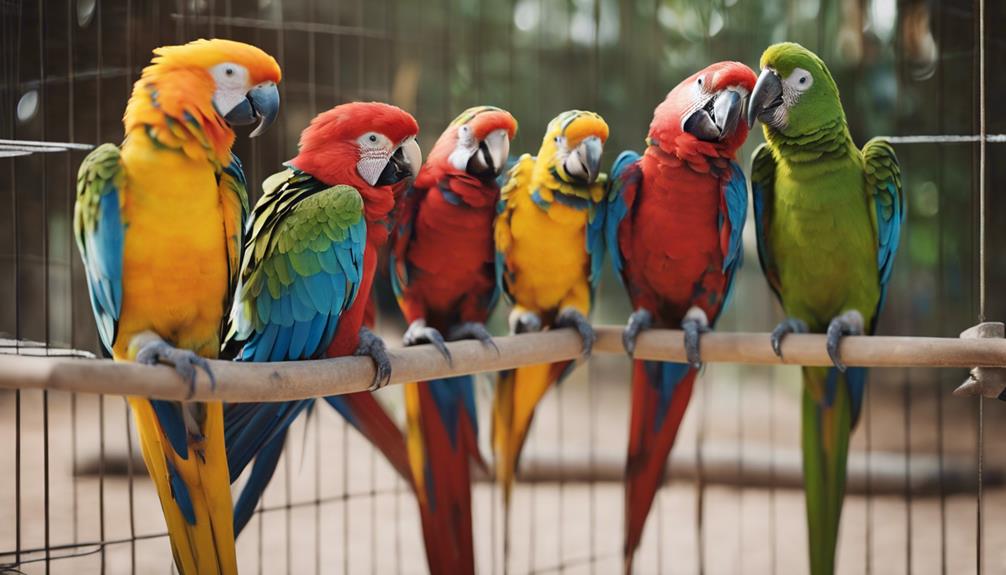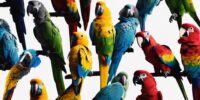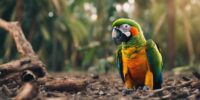How Many Parrot Species Exist and How Are They Categorized?
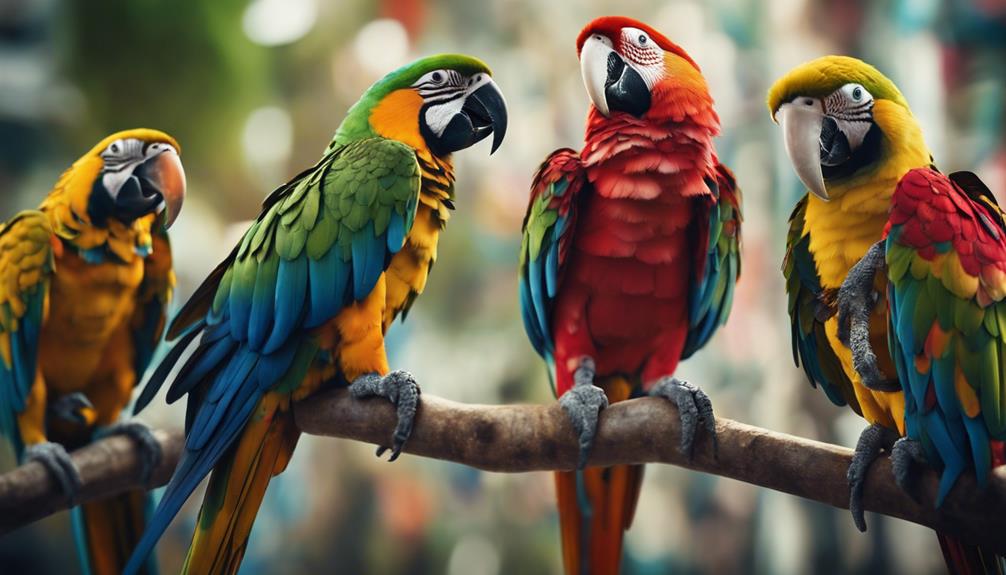
These species are found in most tropical and subtropical regions of the world. Parrots are known for their brightly colored feathers, strong curved bills, and the ability to mimic human speech.
Parrots are also highly intelligent and social birds, often forming strong bonds with their human companions. They have a varied diet that includes fruits, nuts, seeds, and even insects.
In the wild, parrots can be found in forests, grasslands, and savannas, where they play a vital role in pollination and seed dispersal. They are also popular pets due to their playful nature and ability to learn tricks and words.
The Fascinating World of Parrots
The diverse world of parrots comprises approximately 372 species categorized into three distinct superfamilies, showcasing a colorful array of vibrant plumage, unique physical adaptations, and intriguing behavioral traits. Parrots are known for their striking feathers, which come in a wide range of colors and patterns, serving both aesthetic and functional purposes such as camouflage and species recognition.
Despite the dazzling plumage, parrots exhibit minimal sexual dimorphism, making it challenging to distinguish males from females based on appearance alone. This lack of distinct visual cues emphasizes the importance of other behaviors and vocalizations in their social interactions and mating rituals.
However, the beauty and diversity of these avian species face significant threats, with habitat loss being one of the most pressing issues impacting parrot populations worldwide. Deforestation, urbanization, and climate change are leading to the destruction of essential habitats for many parrot species, endangering their survival. Conservation efforts are crucial to mitigate the effects of habitat loss and ensure the long-term viability of these charismatic birds in the wild.
Most Popular Parrot Breeds Kept as Pets at Home
- Budgerigar (Budgie) – Small, colorful, and easy to care for, making them ideal for novice bird owners.
- Cockatiel – Known for their distinctive crest and friendly disposition, they’re great companions.
- African Grey Parrot – Highly intelligent and capable of extensive vocabulary, these birds form strong bonds with their owners.
- Amazon Parrot – Famous for their playful personalities and speaking abilities, but they require lots of interaction.
- Quaker Parrot (Monk Parakeet) – Social and intelligent, Quakers are known for their ability to build large vocabularies.
- Conure (specifically Sun Conure and Green-Cheeked Conure) – These birds are loved for their playful nature and striking colors.
- Eclectus Parrot – Notable for their striking sexual dimorphism in coloration and calm temperament.
- Lovebird – Small, affectionate, and often happy to be in pairs, they’re known for forming strong bonds.
- Cockatoo – With their impressive crests and affectionate nature, cockatoos are charming but demand a lot of attention.
- Indian Ringneck Parakeet – Valued for their beauty and intelligence, they have a knack for learning tricks and mimicking speech.
List of 50 Most Popular Parrots species
| # | Parrot Species | # | Parrot Species |
|---|---|---|---|
| 1 | African Grey Parrot | 26 | Pionus Parrot |
| 2 | Budgerigar (Budgie) | 27 | Meyer’s Parrot |
| 3 | Cockatiel | 28 | Red-Fronted Macaw |
| 4 | Sun Conure | 29 | Blue-Throated Macaw |
| 5 | Blue-and-Gold Macaw | 30 | Military Macaw |
| 6 | Green-Winged Macaw | 31 | Severe Macaw |
| 7 | Scarlet Macaw | 32 | Yellow-Collared Macaw |
| 8 | Hyacinth Macaw | 33 | Hahn’s Macaw |
| 9 | Amazon Parrot | 34 | Jenday Conure |
| 10 | Senegal Parrot | 35 | Green-Cheeked Conure |
| 11 | Quaker Parrot (Monk Parakeet) | 36 | Blue-Crowned Conure |
| 12 | Eclectus Parrot | 37 | Nanday Conure |
| 13 | Indian Ringneck Parakeet | 38 | Patagonian Conure |
| 14 | Alexandrine Parakeet | 39 | Canary-Winged Parakeet |
| 15 | Lovebird | 40 | Dusky-Headed Conure |
| 16 | Cockatoo | 41 | Red-Bellied Parrot |
| 17 | Umbrella Cockatoo | 42 | Vasa Parrot |
| 18 | Sulphur-Crested Cockatoo | 43 | Hawk-Headed Parrot |
| 19 | Goffin’s Cockatoo | 44 | Palm Cockatoo |
| 20 | Moluccan Cockatoo | 45 | Yellow-Naped Amazon |
| 21 | Rainbow Lorikeet | 46 | Blue-Fronted Amazon |
| 22 | Peach-Faced Lovebird | 47 | Double Yellow Head Amazon |
| 23 | Fischer’s Lovebird | 48 | Red-Lored Amazon |
| 24 | Black-Headed Caique | 49 | Tucuman Amazon |
| 25 | White-Bellied Caique | 50 | Lilac-Crowned Amazon |
Global Distribution of Parrot Species
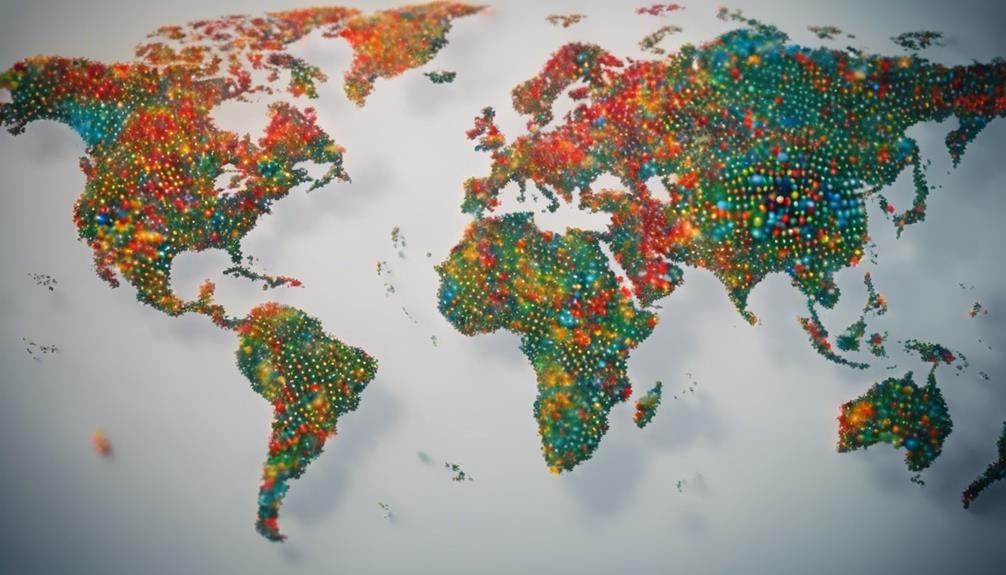
Parrot species exhibit a global distribution pattern, with South America and Australasia standing out as regions hosting the highest diversity of these colorful birds. South America and Australasia collectively harbor approximately 372 parrot species across 86 genera.
Most Popular Parrots in South America and Australia
| # | South America | # | Australia |
|---|---|---|---|
| 1 | Scarlet Macaw | 1 | Budgerigar (Budgie) |
| 2 | Blue-and-Gold Macaw | 2 | Cockatiel |
| 3 | Green-Winged Macaw | 3 | Rainbow Lorikeet |
| 4 | Sun Conure | 4 | Eclectus Parrot |
| 5 | Yellow-Collared Macaw | 5 | Galah |
| 6 | Hyacinth Macaw | 6 | Sulphur-Crested Cockatoo |
| 7 | Amazon Parrot | 7 | Australian King Parrot |
| 8 | Nanday Conure | 8 | Crimson Rosella |
| 9 | Red-Fronted Macaw | 9 | Palm Cockatoo |
| 10 | Military Macaw | 10 | Red-Winged Parrot |
Most Popular Parrots in Africa and Asia
| # | Africa | # | Asia |
|---|---|---|---|
| 1 | African Grey Parrot | 1 | Indian Ringneck Parakeet |
| 2 | Senegal Parrot | 2 | Alexandrine Parakeet |
| 3 | Meyer’s Parrot | 3 | Rose-Ringed Parakeet |
| 4 | Red-Bellied Parrot | 4 | Plum-Headed Parakeet |
| 5 | Cape Parrot | 5 | Red-Breasted Parakeet |
| 6 | Poicephalus Parrot | 6 | Long-Tailed Parakeet |
| 7 | Lovebird: Peach-Faced | 7 | Himalayan Monal |
| 8 | Jardine’s Parrot | 8 | Nicobar Parakeet |
| 9 | Grey-Headed Parrot | 9 | Derbyan Parakeet |
| 10 | Brown-Necked Parrot (Cape Parrot) |
10 | Moustached Parakeet |
Central America, Caribbean and Europe
| # | Central America and the Caribbean | # | Europe |
|---|---|---|---|
| 1 | Cuban Amazon | 1 | Rose-Ringed Parakeet |
| 2 | Hispaniolan Amazon | 2 | Monk Parakeet (Quaker) |
| 3 | Puerto Rican Amazon | 3 | Alexandrine Parakeet |
| 4 | Red-Lored Amazon | 4 | Indian Ringneck Parakeet |
| 5 | Yellow-Naped Amazon | 5 | Blue-Crowned Parakeet |
| 6 | Blue-Headed Parrot | 6 | Senegal Parrot |
| 7 | White-Fronted Amazon | 7 | Cockatiel |
| 8 | Green-Cheeked Amazon | 8 | African Grey Parrot |
| 9 | Orange-Chinned Parakeet | 9 | Budgerigar (Budgie) |
| 10 | Brown-Hooded Parrot | 10 | Conure (various species) |
The distribution of parrot species is influenced by various factors, including habitat preferences. Different parrot species display specific habitat preferences based on their distribution, ranging from dense rainforests to woodlands, savannas, and even arid environments.
The concentration of parrots in regions like South America and Australasia can be attributed to the favorable environmental conditions present in these areas. The tropical and subtropical regions worldwide host a varied distribution of parrot species, with each species adapting to its specific ecological niche.
Understanding the global distribution of parrot species is crucial for conservation efforts and ensuring the preservation of their diverse habitats.
Understanding Parrot Taxonomy
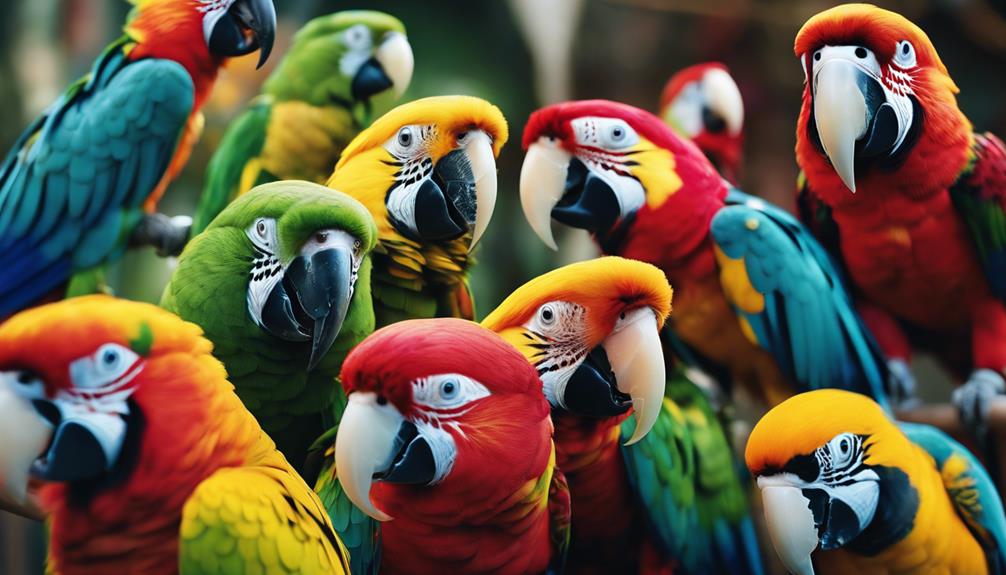
Parrot taxonomy delves into the origins, evolution, etymology, and phylogeny of these fascinating avian species. Understanding the classification of parrots involves examining their ancestral roots, the development of their physical traits, and the genetic relationships between different groups.
Origins and evolution
Having evolved around 59 million years ago in Gondwana, molecular studies have revealed a close relationship between parrots, passerines, and falcons. Fossil records indicate modern parrots emerged around 23-20 million years ago, showing little sexual dimorphism in the visual spectrum. Parrots possess zygodactyl feet for climbing and swinging, showcasing their adaptability in various environments and their distinctive evolutionary traits.
Key Points:
- Molecular studies link parrots to passerines and falcons.
- Fossil records suggest the emergence of modern parrots.
- Parrots exhibit zygodactyl feet for versatile movement and adaptation.
Etymology
The etymology of parrot taxonomy delves into the historical linguistic origins and nomenclature associated with the categorization of these avian species. Parrots are classified into three superfamilies: Psittacoidea, Cacatuoidea, and Strigopoidea, each encompassing distinct groups with unique characteristics. Here is a breakdown of these superfamilies:
| Superfamily | Included Species | Notable Features |
|---|---|---|
| Psittacoidea | Macaws, Lorikeets, Budgerigars, and other parrots | Colorful plumage, strong bills, diverse species |
| Cacatuoidea | Cockatoos | Crested heads, robust bills, subdued color palette |
| Strigopoidea | Kakapo and other unique parrot species | Flightless, found in New Zealand |
Understanding the taxonomy of parrots aids in unraveling their evolutionary relationships and the diversity present within the order Psittaciformes.
Phylogeny
The evolutionary relationships and diversity within the order Psittaciformes can be elucidated through an in-depth exploration of parrot phylogeny.
Key Points:
- Genetic Characteristics: Genetic studies play a crucial role in understanding the evolutionary history of parrots, aiding in the classification of species based on their genetic makeup.
- Evolutionary Relationships: By analyzing phylogenetic relationships among different parrot species, researchers can trace their evolutionary paths and determine how they’re interconnected.
- Conservation Efforts: Knowledge of parrot phylogeny is essential for conservation strategies, helping in the identification of evolutionarily distinct species and prioritizing efforts to protect and preserve their genetic diversity.
Understanding the intricate details of parrot phylogeny not only enhances our comprehension of their taxonomy but also guides conservation initiatives for these fascinating birds.
Classifying Parrots by Size
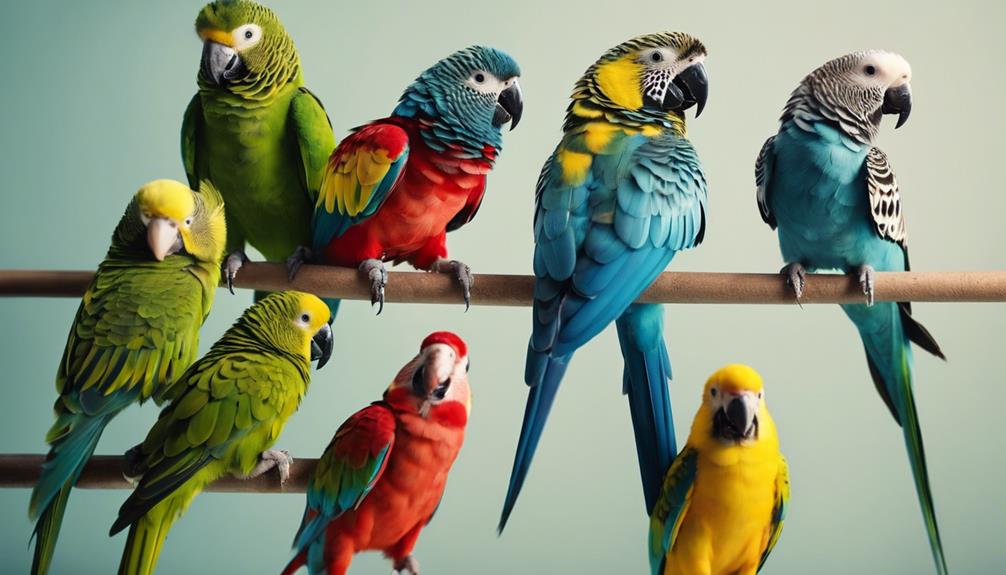
When classifying parrots, their sizes are categorized into small, medium, and large species based on their physical dimensions.
- Small parrot species, like budgerigars, typically weigh around 30-40 grams and have a body length of 18-20 centimeters.
- Medium-sized parrots, such as conures and ringnecks, generally weigh between 50-200 grams and have body lengths ranging from 23-40 centimeters.
- Large parrot species, like macaws, and cockatoos can weigh over 500 grams and have body lengths exceeding 50 centimeters.
Size classification is crucial as it helps in understanding the diversity and range of parrot species, from the tiny pygmy parrots to the majestic hyacinth macaws.
| Size | Weight Range | Body Length Range |
|---|---|---|
| Small | 30-40g | 18-20cm |
| Medium | 50-200g | 23-40cm |
| Large | >500g | >50cm |
Exploring Parrot Color Variations
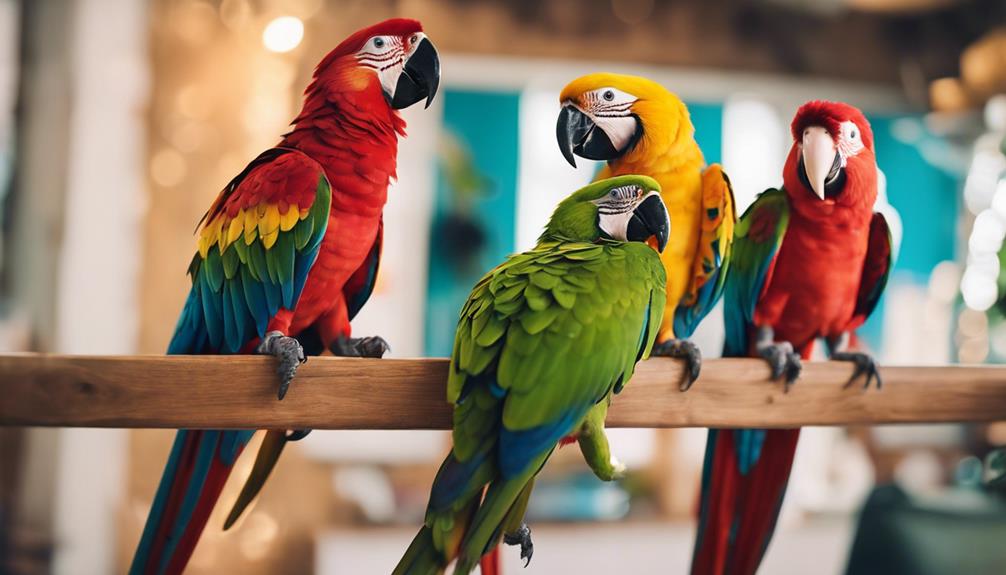
Examining the various hues and patterns of plumage in parrots reveals a diverse spectrum of color variations.
- Parrots exhibit a wide range of color variations including vibrant greens, blues, reds, yellows, and even combinations of these colors.
- Some parrot species have striking color patterns with contrasting hues and unique color distributions on their feathers.
- Color variations in parrots can serve adaptive functions such as camouflage in their natural habitats or signaling for mate attraction.
The coloration of parrots can be influenced by a combination of genetic factors and environmental conditions. Factors such as diet, exposure to sunlight, and genetics play crucial roles in determining the development and vibrancy of colors in these birds.
Additionally, coloration can be essential for mate attraction, with some species displaying specific color patterns to attract potential mates. Understanding the intricate relationships between color variations, feather patterns, mate attraction, environmental factors, and genetics provides valuable insights into the evolutionary adaptations of these colorful avian species.
Behavioral Traits of Parrot Species
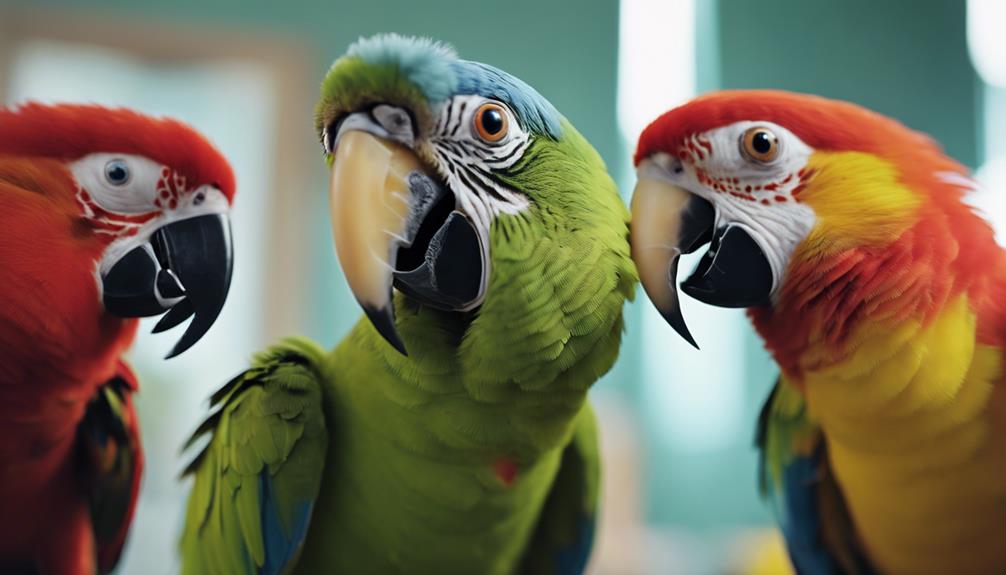
Parrot species exhibit a diverse range of behavioral traits reflecting their intelligence and adaptability in various environments. Renowned for their intelligence, parrots showcase remarkable problem-solving skills, often demonstrating tool-using abilities that highlight their cognitive prowess.
These birds engage in strong social learning behaviors, where early life experiences significantly shape their development and interactions within their communities. Parrots possess exceptional vision, sensitive to ultraviolet light, enabling them to perceive colors and patterns beyond human capabilities.
Their unique syrinx allows for the production of complex vocalizations and impressive vocal mimicry, distinguishing them as exceptional communicators among avian species. Through a combination of intelligent behaviors, social learning, advanced vision, tool-using abilities, and vocal mimicry, parrots showcase a rich tapestry of behaviors that contribute to their adaptability and survival in diverse habitats.
Parrot Species in the Americas
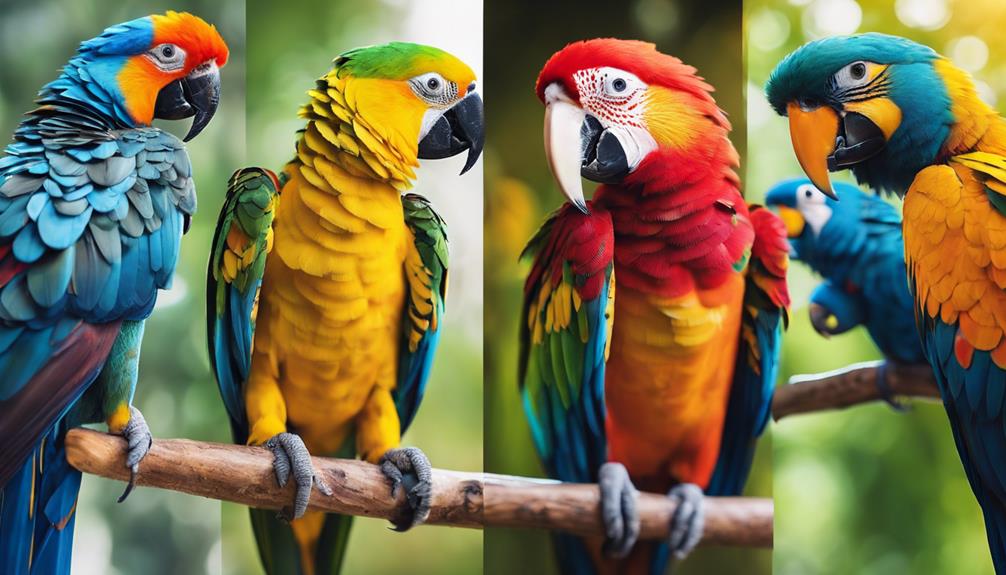
In the diverse ecosystems of the Americas, various species of parrots thrive, showcasing unique adaptations and behaviors.
Key Points:
- The Amazon Rainforest in South America is a hotspot for parrot diversity, housing a significant number of species.
- Some iconic parrot species in the Americas include macaws, conures, and Amazon parrots, known for their vibrant colors and distinct vocalizations.
- Unfortunately, several parrot species in the Americas, like the Spix’s Macaw and the Puerto Rican Parrot, are endangered, emphasizing the urgent need for conservation efforts to protect their habitats and combat illegal trade.
The lush and varied landscapes of the Americas provide a rich tapestry for parrot species to thrive. From the dense canopies of the Amazon Rainforest to the arid regions of the southwest, these colorful birds have adapted to a range of environments.
However, human activities such as deforestation and poaching pose significant threats to their survival, underscoring the importance of dedicated conservation initiatives to safeguard the unique parrot species that call the Americas home.
Parrot Diversity in Australia
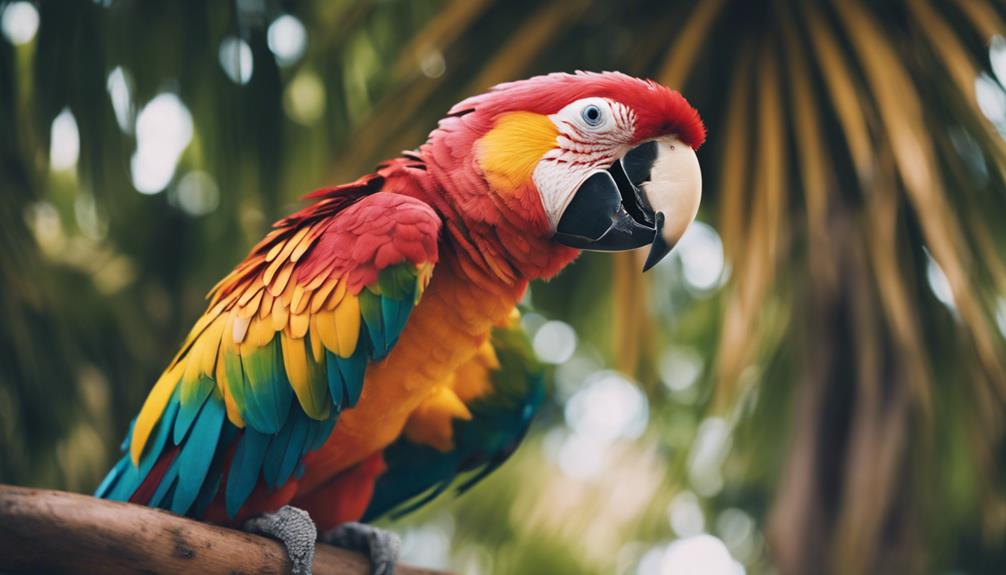
Australia’s diverse landscapes host a rich array of over 50 vibrant parrot species, each showcasing unique colors and behaviors. Australian parrots have adapted to a variety of habitats, from the arid outback to lush rainforests, displaying a remarkable diversity of traits. The table below highlights some iconic Australian parrot species, their unique adaptations, and conservation status.
| Parrot Species | Adaptations | Conservation Status |
|---|---|---|
| Rainbow Lorikeet | Colorful plumage for camouflage | Least Concern |
| Sulphur-crested Cockatoo | Movable head crest for communication | Least Concern |
| Princess Parrot | Desert adaptation for water retention | Near Threatened |
Conservation efforts in Australia focus on safeguarding threatened parrot species like the Swift Parrot and the Orange-bellied Parrot. These initiatives underscore the importance of preserving the habitats crucial for the survival of these unique and charismatic birds.
African Parrot Species Overview
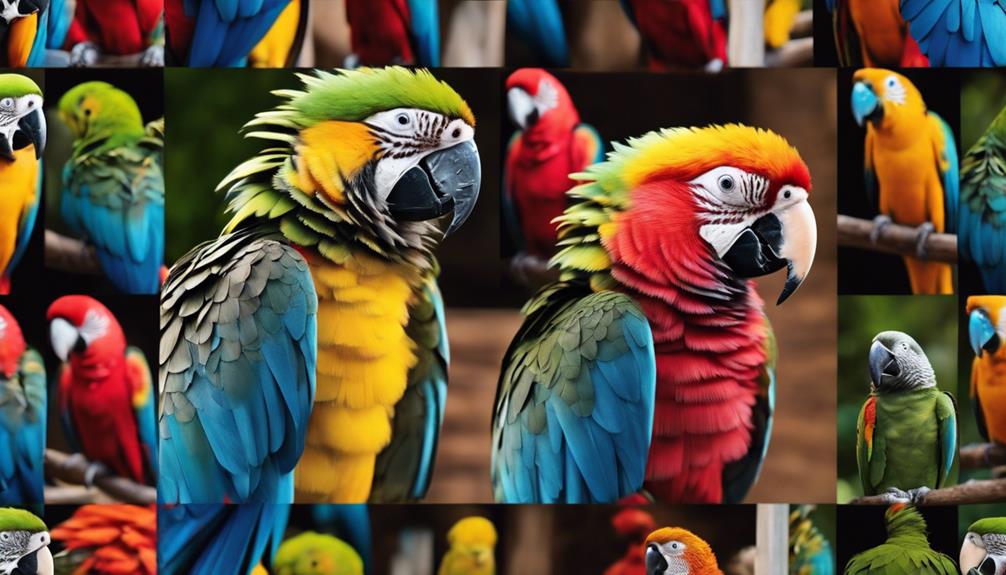
A diverse array of avian species native to the African continent showcases unique traits and adaptations, with notable examples including African Greys, Senegals, and Meyer’s parrots.
African Parrot Species Overview:
- African Grey Parrot: Renowned for its exceptional intelligence and remarkable ability to mimic human speech, the African Grey Parrot is a highly popular and sought-after species in the pet trade.
- Senegal Parrot: Recognized for their playful and affectionate nature, Senegal Parrots form strong bonds with their human companions and are known for their charming personalities.
- Meyer’s Parrot: Characterized by vibrant green plumage and a gentle temperament, Meyer’s Parrots are prized for their beauty and amiable disposition.
These African parrot species face significant threats from habitat loss due to deforestation, trapping for the pet trade, and other human-related activities. Conservation efforts are crucial to safeguard these unique and charismatic birds for future generations.
Parrots of Asia and the Pacific
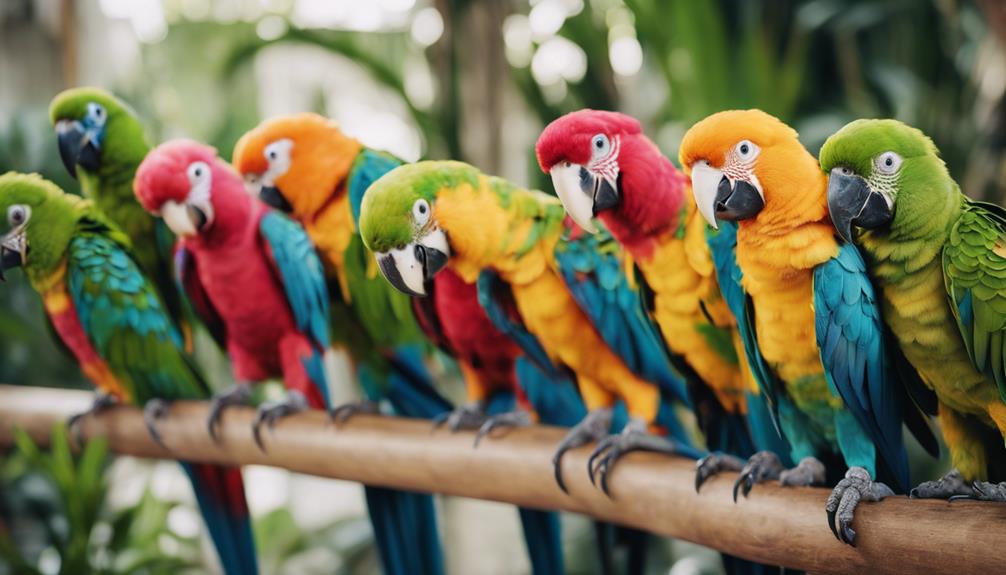
Among the diverse group of parrot species in Asia and the Pacific region, notable representatives include the Indian Ringneck Parakeet, Eclectus Parrot, and Alexandrine Parakeet. These parrots exhibit a wide array of colors, sizes, and behaviors adapted to the varied environments of Asia and the Pacific. Iconic species such as the Australian Cockatiel, Rainbow Lorikeet, and Sulphur-crested Cockatoo contribute to the rich biodiversity of parrots in this region. The parrots in Asia and the Pacific showcase unique adaptations and play crucial roles in their ecosystems.
Conservation efforts in Asia and the Pacific are vital to protect endemic parrot species facing threats such as habitat loss and illegal trade. Preserving the habitats of these parrots is essential for maintaining the delicate balance of biodiversity in the region. By understanding the specific needs and behaviors of parrots in Asia and the Pacific, conservationists can develop targeted strategies to safeguard these fascinating birds for future generations.
Endangered Parrot Species
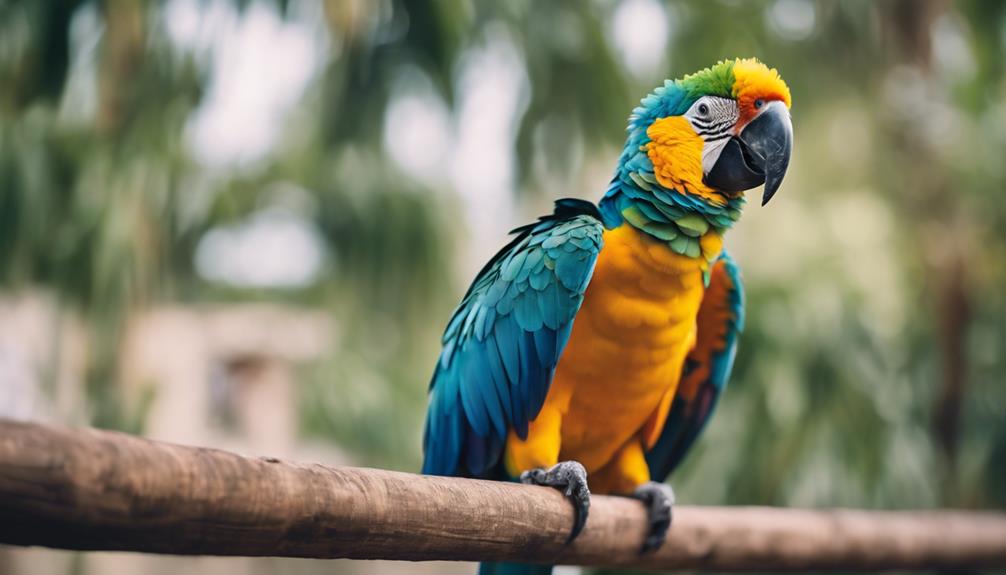
Parrot species around the world face critical endangerment due to various threats, including habitat loss, illegal trapping, and climate change impacts.
- Extent of Endangerment: Approximately one-third of parrot species are threatened with extinction, with 56 species classified as Endangered and 26 as Critically Endangered.
- Threats to Parrots: Endangered parrot species are primarily threatened by habitat loss, illegal trapping for the pet trade, and the adverse effects of climate change on their natural habitats.
- Examples of Endangered Parrots: Species such as the Spix’s Macaw, possibly extinct in the wild, the Red-tailed Black Cockatoo, and the Philippine Cockatoo are facing significant challenges, including population decline and habitat degradation. These examples highlight the urgency of conservation efforts to protect these endangered parrot species from further decline.
Conservation Efforts for Parrots
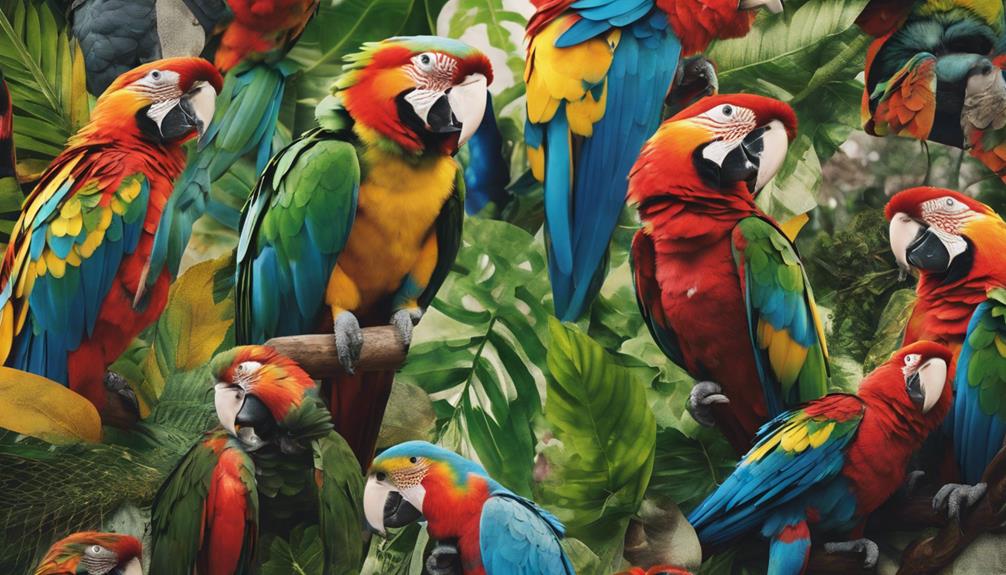
To address the critical endangerment facing numerous parrot species worldwide, concerted conservation efforts are being implemented to safeguard these avian populations from extinction. Approximately one-third of parrot species are threatened with extinction, emphasizing the urgency of conservation measures. The IUCN Red List provides conservation status codes that categorize parrot species based on their endangerment levels, aiding in targeted conservation strategies. Range maps are utilized to monitor the distribution of parrot species and guide specific conservation initiatives. Conservation status symbols indicate the varying levels of threat faced by each species, ranging from Extinct to Least Concern. Conservation efforts primarily focus on protecting parrots from habitat destruction, overexploitation, and other threats to ensure their survival in the wild.
| Conservation Efforts | Description | Importance |
|---|---|---|
| IUCN Red List | Categorizes species based on endangerment | Guides targeted conservation strategies |
| Range Maps | Track species distribution for conservation | Aid in specific conservation initiatives |
| Conservation Status Symbols | Indicate threat levels for species | Help prioritize resources for at-risk populations |
Where is the worlds largest parrot breeding colony?
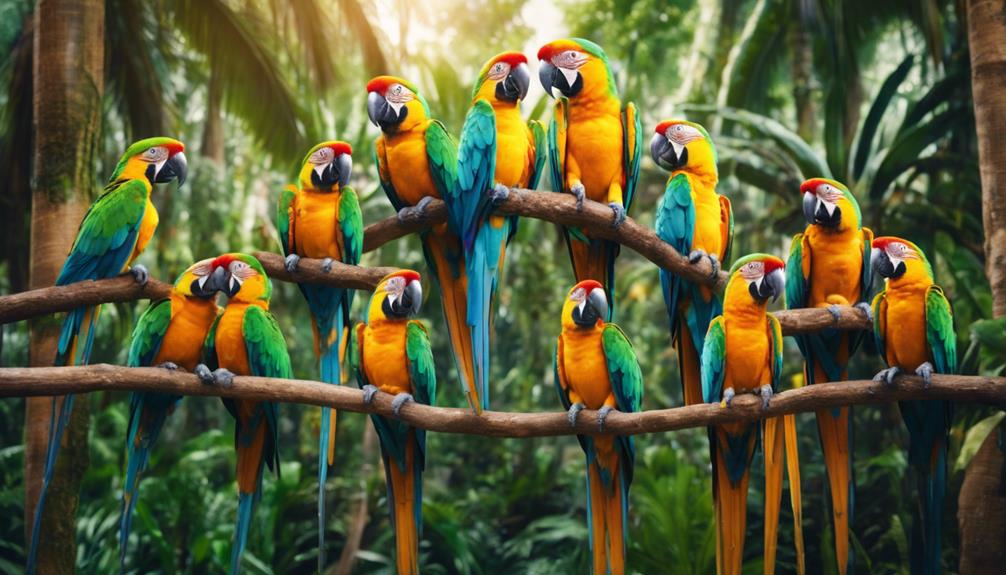
The Tambopata National Reserve in Peru hosts the world’s largest parrot breeding colony, a critical conservation area for over 1,300 macaws. This reserve plays a pivotal role in the preservation of these vibrant birds through various conservation efforts.
Key Points:
- Abundance of Macaws: With a population exceeding 1,300 macaws, the Tambopata National Reserve serves as a significant breeding ground for these majestic birds.
- Unique Breeding Behavior: Macaws in the reserve exhibit fascinating nesting behaviors, often choosing large clay cliffs as their preferred nesting sites.
- Conservation Initiatives: The conservation efforts within the Tambopata National Reserve focus on safeguarding the diverse parrot species and their nesting habitats, ensuring the long-term survival of these iconic birds.
The research conducted within the Tambopata National Reserve not only sheds light on the behavior and ecology of macaws but also contributes to the broader understanding of conservation strategies for parrot populations worldwide.
Frequently Asked Questions
How Many Species Are There of Parrots?
Parrots exhibit remarkable diversity with approximately 372 species across 86 genera. They are classified into three superfamilies and further into families like Psittacidae and Cacatuidae, each showcasing unique physical traits and behaviors.
What Are the 7 Classifications of a Parrot?
Parrots are classified into Kingdom, Phylum, Class, Order, Family, Genus, and Species. The seven classifications help differentiate species based on various factors like physical traits, behavior, and genetics, contributing to a comprehensive understanding of these fascinating birds.
How Many True Parrots Are There?
Parrot enthusiasts marvel at the diverse world of true parrots, approximately 160 species residing in the Psittacidae family. These colorful birds, including macaws and conures, captivate with vibrant plumage, strong bills, and zygodactyl feet.
What Are Groups of Parrots?
Parrots are classified into Psittacoidea, Cacatuoidea, and Strigopoidea groups. Psittacidae and Cacatuidae families contain true parrots and cockatoos, respectively. These groups are further divided based on physical traits, behaviors, and genetics for precise categorization.
